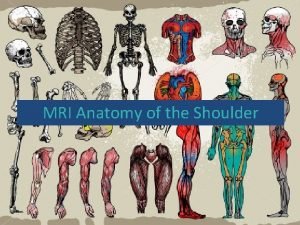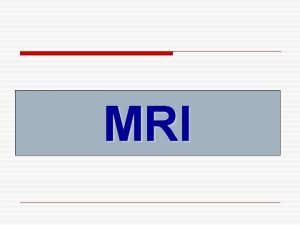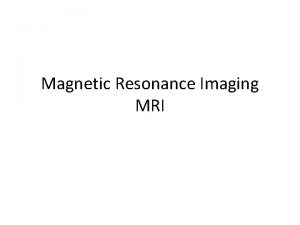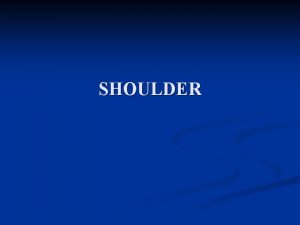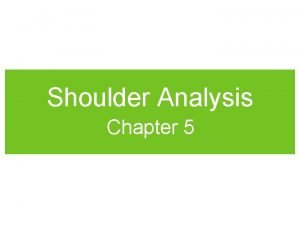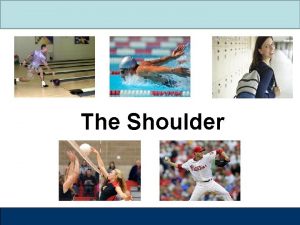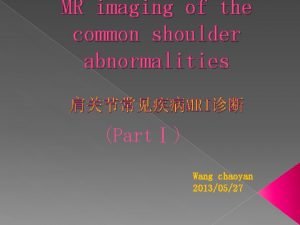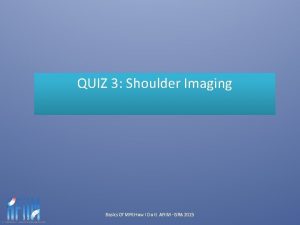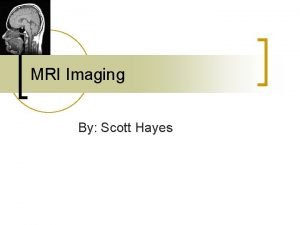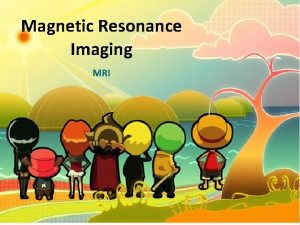SUMMARY OF SHOULDER IMAGING MRI of the shoulder







![SUMMARY OF SHOULDER IMAGING Bones [acromion, acromio-clavicular joint, humeral head] Acromion: The acromial shape SUMMARY OF SHOULDER IMAGING Bones [acromion, acromio-clavicular joint, humeral head] Acromion: The acromial shape](https://slidetodoc.com/presentation_image_h2/7d54881d63b085f6adc8a610a7fa188e/image-8.jpg)




- Slides: 12

SUMMARY OF SHOULDER IMAGING MRI of the shoulder joint Source: Handout & Lecture of Prof. Mamdouh Mahfouz www. radiologyassistant. nl Indications: - - History of trauma Pain and/ or swelling Deformity Limitation of movement Technique of examination: Patient preparation: No preparation required o fast for 4 -6 hours. if contrast material or will receive anesthesia o Contrast material is Gadolinium DTPA, dose is 0. 1 -0. 2 mmol/ Kgm body weight. o Anesthesia to unstable patients all the time of examination [Pediatric and uncooperative patients] Procedure: Supine position of the patient Surface coil special for shoulder Protocol of examination should include: Axial localizer Coronal "Main" T 1, T 2 WIs and PD Axial T 1 and gradient images Sagittal T 2 WIs Coronal gradient or STIR (optional) When contrast material is injected axial, sagittal and coronal T 1 WIs are obtained. Contrast is injected whenever inflammatory or neoplastic lesions are suspected. NB The optimal field of view [FOV] for the shoulder is about 20 cm. Good Surface coil = close to organ , not moved with respiration Extremity MR Machine is not suitable for shoulder By A. M. Abodahab – Ass. Lecturer of Radiology - Sohag University

SUMMARY OF SHOULDER IMAGING Landmark of Scan : o Axial Localizer o Identify "ICE CREAM CONE" = Main axis of scan Coronal Sagital Angle other than this = Scan Must be repeated Image interpretation [ Normal anatomy] Items to assessed: Tendons Labrium Ligaments Bursae Bones Acromion, acromio- clavicular joint, humeral head Synovial effusion Supraspinatous, Infraspinatous, subscapularis, Biceps Anterior, Posterior, Superior, Inferior Superior, middle and inferior Glenohumeral ligaments Subacromial- subdeltoid, subcoracoid and subscapularis bursae By A. M. Abodahab – Ass. Lecturer of Radiology - Sohag University

SUMMARY OF SHOULDER IMAGING Tendons: All tendons appear normally black in all pulse sequences [Mature fibrous tissue contains non mobile H protons] � Supraspinatous tendon is assessed in the coronal T 1 and T 2 WIs First identify the acromio-clavicular joint then look underneath the joint you can see the black signal band inserting into the humeral greater tuberosity [In the same image you can see the subacromial bursa above the tendon however the bursa is not seen unless it is filled with fluid in cases of bursitis or rupture of the supraspinatous tendon] NB Intermediate signals may be seen within the tendon in T 1 and PD images which are normal variants, these signal should not be normally seen in T 2 WIs By A. M. Abodahab – Ass. Lecturer of Radiology - Sohag University

SUMMARY OF SHOULDER IMAGING � Infraspinatous tendon is also assessed in the coronal images underneath the spine of the scapula. The tendon also interests into the humeral greater tuberosity. � Subscapularis tendon is best assessed in the axial image at the level of the bicipital groove NB The bicipital groove is a notch seen in the anterior aspect of the humeral head separating between the greater and lesser tuberosities. In Coronal Images it seen under coracoid. The subscapularis tendon appears as a thick low signal band stretched between the lesser tuberosity and the subscapularis muscle. In the same images if you look along the posterior aspect of the humeral head you will see the infraspinatous tendon [another site where you can evaluate the infraspinatous tendon] By A. M. Abodahab – Ass. Lecturer of Radiology - Sohag University

SUMMARY OF SHOULDER IMAGING By A. M. Abodahab – Ass. Lecturer of Radiology - Sohag University

SUMMARY OF SHOULDER IMAGING By A. M. Abodahab – Ass. Lecturer of Radiology - Sohag University

SUMMARY OF SHOULDER IMAGING The biceps tendon appears as a small ball of low signal inside the bicipital groove in the axial images NB If you want to see the whole length of the biceps tendon go to the most anterior images of the coronal sections then you will seen the tendon in the bicipital groove crossing over the humeral head to insert into the superior labrium- glenoid complex. In the same image you can see the subscapularis tendon as well as the coracoid process. Underneath the coracoid process lies the subcoracoid bursa which is not usually identified unless filled with fluid. For better assessment of the biceps tendon, MR arthrography is usually indicated. Glenoid labrium: The labrium is triangular in shape, the base of the triangle is attached to the glenoid part of the scapula while the apex of the tringle points to the humeral head The labrium appears normally black in all pulse sequences [fibro-cartilagenous tissue contains non mobile H protons] The anterior and posterior labrium are assessed in the axial images [assess the anterior labrium in the same image where you assess the subscapularis tendon, not in any other plane] The superior and inferior labrium are assessed in the coronal plane Bursae: Normally the bursa is not seen unless filled with fluid [either due to synovial effusion, inflammation or after arthrography] Fluids appear of low signal in T 1 WIs and high signal in T 2 WIs [In cases of arthrography the injected contrast material will appear of high signal in T 1 and T 2 WIs] The subacromial bursa is seen in the coronal images above the supraspinatous tendon and below the acromio-clavicular joint "& extend below deltoid The subcorcoid bursa is seen in all images underneath the corcoid process [The subcorcoid bursa is usually continuous with the joint space, so you can see fluid in the bursa if there is synovial effusion in the joint, then do not diagnose bursitis in such case] The subscapularis bursa is located underneath the subscapularis tendon. This bursa is not frequently seen in the clinical practice. By A. M. Abodahab – Ass. Lecturer of Radiology - Sohag University
![SUMMARY OF SHOULDER IMAGING Bones acromion acromioclavicular joint humeral head Acromion The acromial shape SUMMARY OF SHOULDER IMAGING Bones [acromion, acromio-clavicular joint, humeral head] Acromion: The acromial shape](https://slidetodoc.com/presentation_image_h2/7d54881d63b085f6adc8a610a7fa188e/image-8.jpg)
SUMMARY OF SHOULDER IMAGING Bones [acromion, acromio-clavicular joint, humeral head] Acromion: The acromial shape is assessed only in the sagittal images. There are 4 types of acromion Type I with concave under surface. Type II with straight under surface. Type III with inferior hook. Type IV with convex under surface. Type I and II are normal shapes of the acromion while type III and IV are considered pathological. NB NB The acromial shape should be mentioned in the report whether normal or abnormal. Acromio- clavicular joint: best evaluated in the coronal and sagittal planes. The normal joint has a smooth upper and lower surfaces with no superior or inferior bulges. The acromion and clavicle should show normal marrow signal in all pulse sequences. Humeral head is assessed in all images specially the axial images. Normally it has a smooth cortical outline. The biceptal groove is seen in its anterior aspect. The humeral head usually show heterogenous marrow signal reflecting the presence of red and yellow marrow. The red marrow normally shows intermediate signal in all pulse sequences. By A. M. Abodahab – Ass. Lecturer of Radiology - Sohag University

SUMMARY OF SHOULDER IMAGING NB A notch may be seen in the superior- lateral aspect of the humeral head near the insertion of the supraspinatous tendon in the coronal images [normal variant]. Synovial effusion: No fluids normally seen within the shoulder joint. When joint effusion is present, it is best assessed in the coronal T 2 WIs filling the axillary pouch NB The axillary pouch is the space between the glenoid bone and humeral head in the inferior aspect of the shoulder joint. This pouch is formed by the inferior glenoid humeral ligament which is attached near the inferior labrium connecting the glenoid to the humeral head. NB The shoulder joint space is normally connected to The sheath of the biceps tendon. The subcoracoid bursa. So You should normally expect some fluid in these two anatomic sites when shoulder joint effusion is present. Glenohumeral ligaments [ superior, middle, inferior] All ligaments appear normally as low signal lines in all pulse sequences [mature fibrous tissue contains non mobile H protons] NB Inferior gleno- humeral ligament [IGHL] best evaluated in the coronal images forming the axillary pouch. The ligament is not usually discriminated from the inferior glenoid labrium (both appear low signal in all pulse sequences). Separation of the ligament from the labrium can be achived when joint effusion is present or after shoulder arthrography. Avulsion of the glenoid attachement of the IGHL= GAGL Avulsion of the humeral attachment of the IGHL = HAGL Middle gleno- humeral ligament [MGHL] best evaluated in the axial images. Normally it appears as a thin short line between the subscapularis tendon and the anterior glenoid labrium. NB By A. M. Abodahab – Ass. Lecturer of Radiology - Sohag University

SUMMARY OF SHOULDER IMAGING This ligament may be normally absent in about 15% of cases Thickening of the ligament is considered normal variant and is known as "Buford complex" By A. M. Abodahab – Ass. Lecturer of Radiology - Sohag University

SUMMARY OF SHOULDER IMAGING MR shoulder arthrography Is now considered the accurate method for evaluation of the shoulder anatomy and pathology. Many radiologists and clinicians believe that without arthrography, the conventional MR examination of the shoulder can miss a lot of abnormalities. �Technique: 1 ml of Gd – DTPA diluted in 20 ml normal saline injected into the shoulder joint space under screen control with the patient supine and his arm is slightly abducted and externally rotated [about 5 - 10 ml of the diluted contrast are injected, some iodinated contrast material like urographin is added to the solution so that you can see the fluid while injected under screen control] NB You should know that Gd- DTPA is not radioopaque? ! �Diagnostic value Normal anatomy: some of the anatomical structures are not easily evaluated without arthrography such as: All the gleno- humeral ligaments specially the superior one. The whole course of the biceps tendon The inferior labrium. Pathology: Many lesions require MR arthrography for adequate delineation and accurate assessment such as: All types of supraspinatous tendon tears specially the minor ones All types of anterior labral tears specially Persth's type, GLAD type and ALAPS type. All types of SLAP injuries except type I lesions All types of gleno- humeral ligament injuries including HAGL, GAGL, tears of the MGHL and SGHL By A. M. Abodahab – Ass. Lecturer of Radiology - Sohag University

SUMMARY OF SHOULDER IMAGING By A. M. Abodahab – Ass. Lecturer of Radiology - Sohag University

